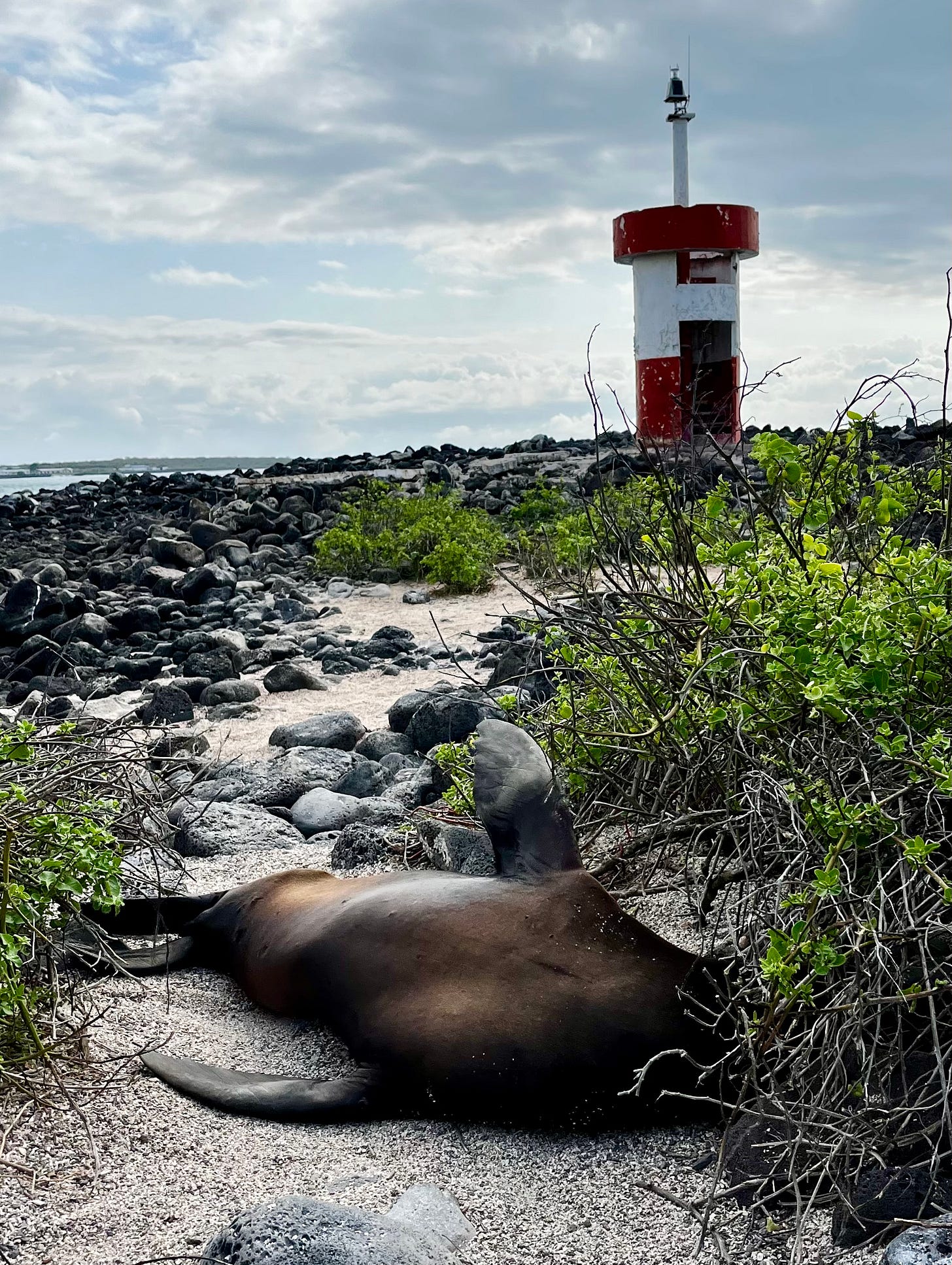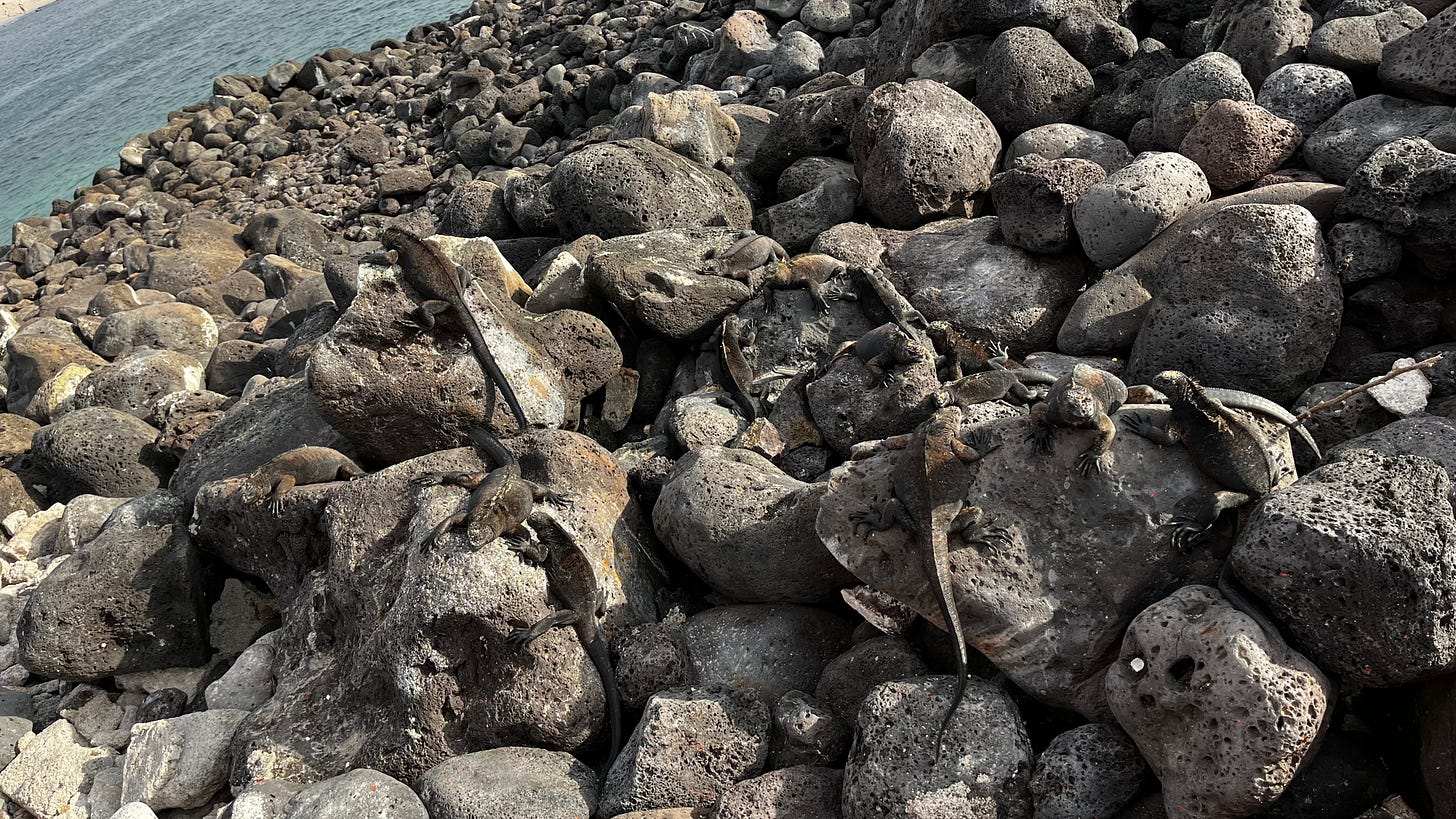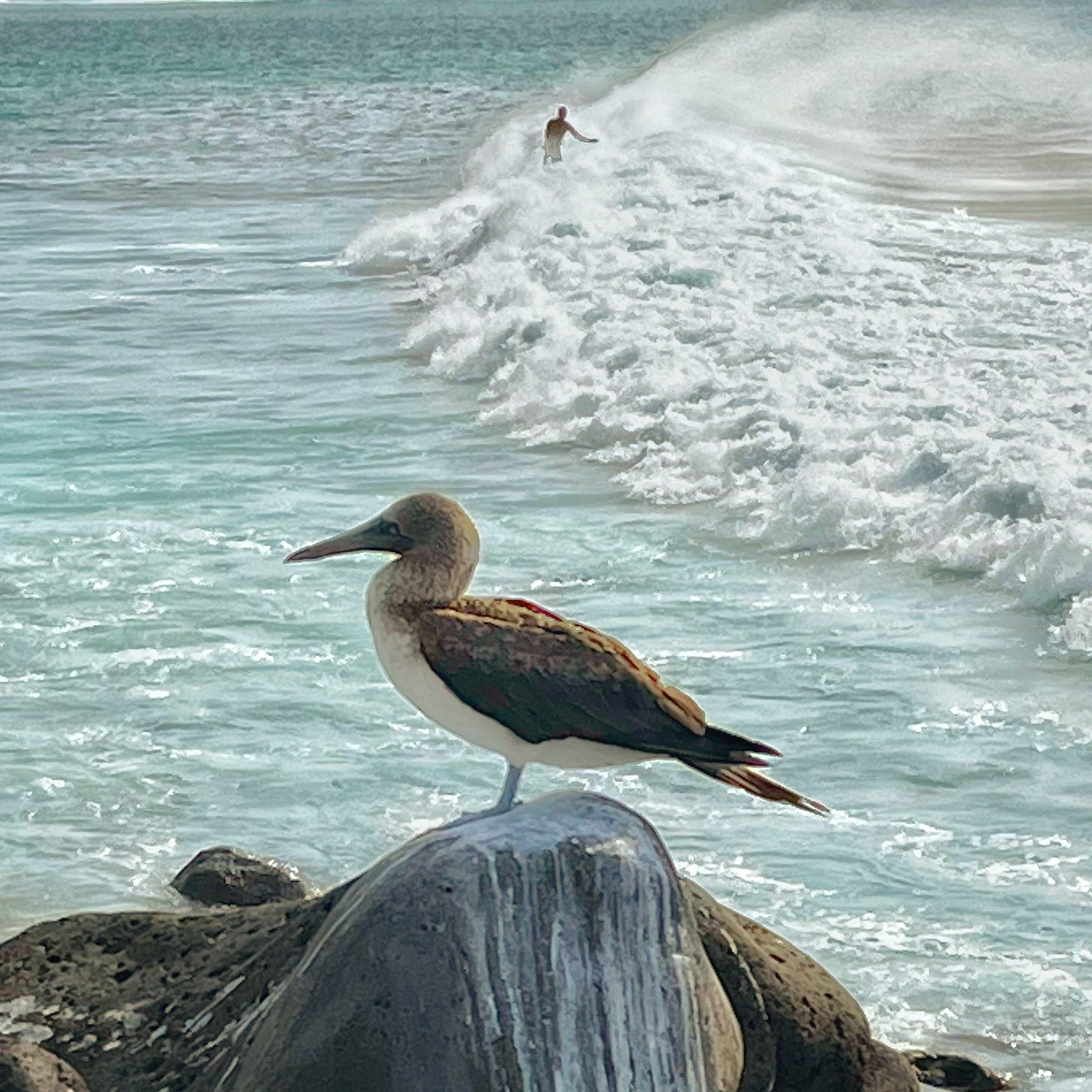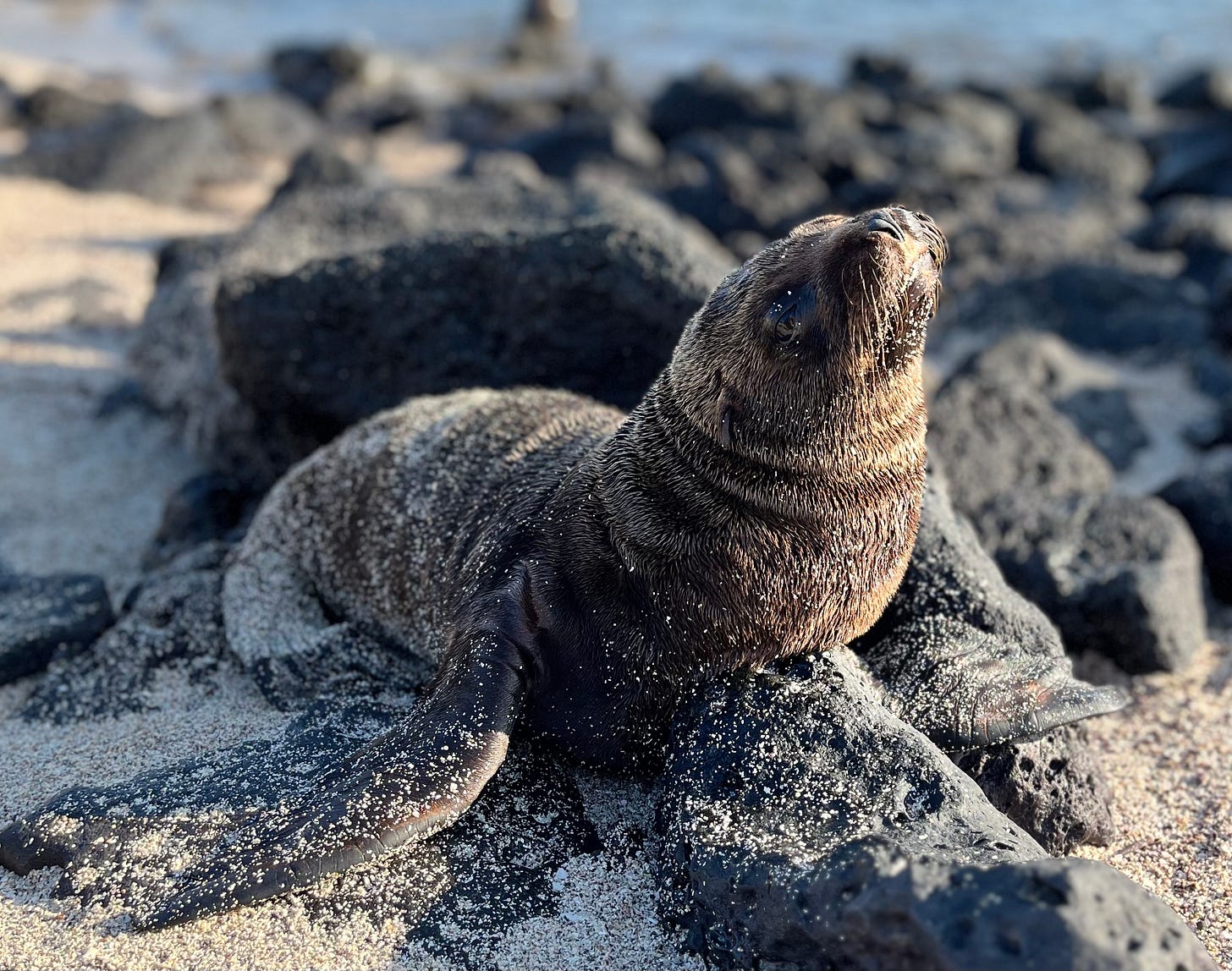# 30 Journey to the Galápagos (II): Exploring San Cristóbal
on prudence, boobies, and other close encounters with animals

This is Journey to the Galápagos, Episode II. In case you missed last week’s episode I, you can read it here.
Sharp rocks in the shallows
After our joyful encounter with sea lions the previous day, we’re keen to venture farther and explore life beneath the water.
We leave in the afternoon, because I enjoy writing in the morning. Writing, reading, cooking, accounting, getting the day’s magical and ugly tasks out of the way. It’s also a healthy schedule in places near the equator where UV radiation can climb up to 12. It’s only after 2:30 pm that we slather on our reef-safe sunscreens, put on our rash guards and caps, and head out.
A 15-minute walk along the harbor bay gets us to Playa Mann, where sea lions and humans share the water and sand as though living in harmony makes far more sense than living in conflict.

Should we swim here or push on toward the next beach? It’s not particularly crowded on Playa Mann, yet the presence of a restaurant and several (not hawking) street vendors makes this beach less unspoiled than we’d like it to be.
We keep going for another 15 minutes and arrive at the larger Playa Punta Carola, where there is less civilization and more wild life. I stand in the shallows with my snorkel, poised to dive, when a man warns me about sharp rocks. His girlfriend hurt her foot the precious day and had to go to the hospital. I see what he means: The lava rocks are all over the shore. I don’t have water shoes and it’s low tide, so the chances of injuring myself and scraping my knees are real.
“Let’s go bouldering instead,” I tell Daniel.
The unusual tameness of the fauna is no myth
We climb on the black lava boulders toward the lighthouse—it’s always motivating to have a goal—and come upon a path that’s obstructed by what looks like a lazy uncle, head in the shade, sleeping off his hangover. (Not that I ever had such an uncle in my family of course.)
Behind the broken light house, we come upon a… what’s the collective noun for marine iguanas? A menace of marine iguanas? A tableau vivant? They conglomerate to stay warm, I read, and sometimes sleep in a heap, yet here they’re merely in one another’s presence, slyly, as though secretly planning a coup.
"It is a hideous-looking creature, of a dirty black colour, stupid, and sluggish in its movements,” wrote Charles Darwin in his diary about marine iguanas when he met them in 1835. I disagree: most seem contemplative and move very quickly when they want.
Two human surfers with boards under their arms pass us by and clamber into the ocean. The waves they dare to ride are magnificent, and when the sun shines through the cascade, sea lions appear, frolicking in the water in jubilation.
We sit on the warm lava rock when I spot my first booby. Its feet are incredibly and undeniably blue—as blue as a plastic toy. I photograph the bird from a distance, creep closer, take another shot, creep closer still. The booby seems undisturbed by my presence, as it seems undisturbed by the nearby presence of a huge marine iguana (that frightens me a bit). Spanish sailors called this sea bird “bobo” at first, which means “foolish,” perhaps because they looked down upon the bird’s trusting nature. Later, the name turned into booby. One thing is sure: The unusual tameness of the fauna on the Galápagos Islands is no myth.
The Blue-Footed Booby
Average life span: 17 years
Average wing span: 1,5 m (5 ft)
Diet: anchovies and sardines
Interesting facts: they fish in groups and often sit on rocks together, too. Females select males with the bluest feet, taking the bright color as an indicator of good health (and genes).
Prudence first, yet again
From Playa Punta Carola a rocky trail leads into the promontory where multiple paved paths diverge. We haven’t researched this area in advance and pick a path at random, willing to see where chance will take us. Prickly pears and candelabra cacti rise from the barren land. A sparsely flowering cotton plant waves in the breeze.
Soon, we’re walking in a ghost forest of slender palo santo trees. Their dormant branches are bare, yet their barks are covered with pastel-colored lichen. I’m reminded of Annie Dillard’s writing in Teaching a Stone to Talk, a book I’m keen to re-read. She went to the Galápagos Islands twice, first to “keep an eye on things,” be a witness. Later for the palo santo trees.


“The palo santo trees bear the lichens effortlessly, unconsciously, the way they bear everything. Their multitudes, transparent as line drawings, crowd the cliffsides like whirling dancers, like empty groves, and look out over cliff-wrecked breakers toward more unpeopled islands, with their freakish lizards and birds, toward the grieving lagoons and the bays where the sea lions wander, and beyond to the clamoring seas.”
—Annie Dillard in Teaching a Stone to Talk
We arrive at a man-made platform on the shore locally known as Muelle Tijeretas. Can we finally swim here? Stone steps lead into the water, so diving in is easy, but the waves are rough on this side of the island, so scrabbling back up will not be smooth. We see no other humans in the water.
Again we decide to play safe. This is why we slow-travel and stay in places for longer than usual. We don’t want to feel pressured to seize the moment when prudence tells us to wait it out. Or perhaps we’re no longer young and adventurous. Either way, I feel no shame.
Instead of swimming, we climb to the Mirador Cerro Tijeretas, a wooden platform with a glorious view. The hill is known in English as Frigate Hill, and it’s true that we see these large birds high in the sky, gliding on the wind. But when I later look up the meaning of “tijereta” in Spanish, I get “earwig” at first, then with further research, “flycatcher.” What’s getting lost in translation?
Sunset with sea lion pups
By the time we return to Playa Mann, the sun is about to set. We can still snorkel, but the visibility will be low, and, with my eternal fear of sharks that feed at night, I’m hesitant to go in. So I content myself—a real hardship—with watching the sea lion pups playing and feeding.
One particularly cute one comes up to me. Who are you? it seems to say. Why are you not petting me? In contrast to mine, its curiosity remains unspoiled by fear.
I restrain myself from taking this puppy into my arms. Touching the animals isn’t allowed. My scent may linger on their skin, causing them to be rejected. Sea lion mothers and their offspring recognize one other by scent and sound, a special call.
It’s only when I come out of my close encounter with the sea lion pup that I notice the mosquitos. By then it’s too late: They’ve sucked my blood. Fortunately, these dusk mosquitoes carry no diseases here at the moment. I’ll just have to resist scratching my bumps for a few days.
The Galápagos Sea Lion
Average life span: 15-20 years
Average weight of the male: 250 kg (550 lbs), with a maximum weight of 400 kg (880 lbs), average weight of the female: 80 kg (176 lbs), with a maximum of 110kg (242 lbs)
Gestation period: 9 months, nursing: 12 months
Interesting facts: Sea lions are the most abundant marine mammal in the archipelago. They live in two types of colonies, harems and groups of bachelors. In a harem, one dominant bull lives with up to 15 females. The leftover males group together and regularly challenge the dominant bulls.
More time, please!
The next day, we wake up sad with the realization that tomorrow will be our last day on San Cristóbal: We’ve only booked four nights. I message our host on Santa Cruz, our next island destination, to see whether we can postpone our booking and ask our current host for an extension of two days. Both women are flexible and able to accommodate our wishes. We’re so lucky—four more days to go!
The Galápagos is changing me in ways I cannot yet fully grasp. I read the news, variations on the theme of human violence, without getting wildly upset. Is it because we’re so isolated here in this archipelago? Or because the natural beauty of our world is so definitely present that it outshines all current affairs? Whatever it is, I feel more part of our planet than ever before.
San Cristóbal Island
Size: 557 km2 (215 mi2)
Highest extinct volcanic crater: 730 m (2395 ft)
Population: approximately 6,000
Main town: Puerto Baquerizo Moreno
Interesting fact: Darwin arrived here first in 1835 at the age of 26. He wouldn’t publish On the Origin of Species until a quarter of a century later.
Author News
I’m preparing a post about my upcoming book, the flash fiction collection Woman of the Hour: Fifty Tales of Longing and Rebellion. It won’t be available until July 2025, but my publisher and I are already hard at work behind the scenes.
Contact me if you want a review copy, interview me, host me on your podcast, publish a guest post from me, or anything else you can think of that might help this book find its way to readers.
Related Posts
Previous episodes of our Journey to the Galápagos:
Time to Say Goodbye
I don’t have time to write down all that’s happening each day. Have my days have ever been this full with awe and wonder? Daniel and I are on Santa Cruz by now, a week into our month-long stay on a self-sustainable cacao farm in the highlands, and last night as I was watching the sunset from my hammock, an owl landed on the terrace balustrade two feet from my face. The bird turned its head and stared at me.
All my best,
Claire
P.S. I don’t have a post scriptum this week, but by not breaking the habit, I’m birthing an oxymoron, which I’ve always wanted to do.













I would like to ask you a private, but not personal, question about the Galapagos. Would that be possible? If so, please send the best way to contact you to my email address, which is.kcvictor1@gmail.com. Thank you.
"Do I get bonus points for photographing two species at once?" - For the record, yes, you do. LOL
Your restraint in not petting these sea lions is admirable. If I had been traveling with someone, he or she would have to watch me like a little kid because I would seriously want to pet/hold/take home, etc. LOL
So, that heat index of 12. Is that, like, on par with Hell or maybe just the first level flames-licking-at-your-feet Hell? In that second pic, that woman's legs in the background look a little toasty. I should know all about heat indexes since I live in AZ, but I don't. I just know that for a certain number of months we're cooking like fried chicken over here. LOL